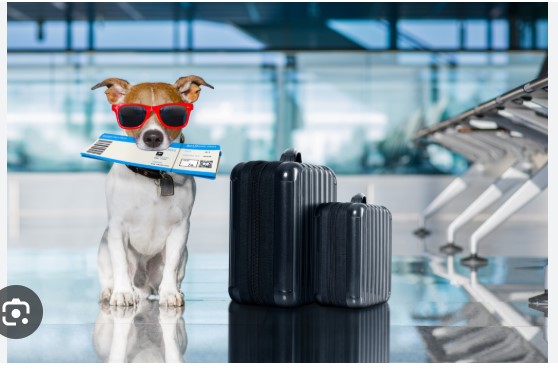
Planning a move to the Land of Smiles? If you’re bringing your furry friend along, you’ll need to navigate the process of getting a Thailand pet import permit. While it might seem complicated, with the right information and preparation, you can ensure a smooth journey for your beloved companion. This guide will walk you through every step, from the initial paperwork to your pet’s arrival in Thailand.
Moving to a new country is a significant undertaking, and bringing a pet adds an extra layer of planning. The Thai authorities have specific regulations in place to protect the country’s biosecurity and ensure the health of all animals. Following these rules is not just a legal requirement; it’s a crucial part of responsible pet ownership.
By understanding the process for obtaining a Thailand pet import permit, you can avoid last-minute stress, unexpected costs, and potential quarantine delays. We’ll cover everything you need to know to make your pet’s relocation as seamless as possible.
What is a Thailand Pet Import Permit?
A Thailand pet import permit is an official document issued by the Department of Livestock Development (DLD). This permit grants you permission to bring your pet (typically a cat or dog) into the country. It certifies that your pet meets all of Thailand’s health and vaccination requirements. Without this permit, your pet will be denied entry upon arrival.
It’s important to start this process well in advance of your travel date, as gathering the necessary documents and receiving approval can take time.
How to Get a Thailand Pet Import Permit: A Step-by-Step Guide
Follow these steps carefully to secure the necessary permit and prepare your pet for travel to Thailand.
Step 1: Microchip Your Pet
Before you do anything else, ensure your pet has an ISO-compliant 15-digit microchip. This is a mandatory requirement for pets entering Thailand. The microchip number must be recorded on all of your pet’s health and travel documents, including the vaccination records and health certificate. If your pet already has a microchip, verify that it’s an ISO-compliant model. If it isn’t, you may need to have a new one implanted or travel with your own compatible scanner.
Step 2: Check Vaccinations
Your pet must be up-to-date on all required vaccinations. The key requirements are:
- Rabies Vaccination: Your pet must be vaccinated against rabies at least 21 days before your departure date. The vaccination must be administered after the microchip is implanted. If your pet is vaccinated before being microchipped, it will need to be revaccinated. The vaccination must still be valid upon arrival in Thailand.
- Other Vaccinations:
-
- For dogs: It’s required that they are vaccinated against Leptospirosis. They should also be vaccinated against Distemper, Hepatitis, and Parvovirus.
-
- For cats: Vaccination against Feline Panleukopenia (FPV) is required.
All vaccinations must be recorded in a pet passport or an official vaccination record book by a licensed veterinarian.
Step 3: Apply for the Import Permit
This is the core of the process. You must apply for the Thailand pet import permit from the DLD before your pet travels. You can do this in two ways:
- Via Email: This is the most common method for international applicants. You will need to email the Animal Quarantine Station at your intended port of entry (e.g., Suvarnabhumi Airport in Bangkok) at least 15 days before your travel date.
- In-Person (by a representative): If you have a representative in Thailand, they can apply on your behalf at the quarantine station.
You will need to submit a set of scanned documents with your application (Form R-1/1). These documents typically include:
- A copy of the pet owner’s passport.
- A copy of the pet’s microchip and vaccination records.
- A photograph of your pet.
- Details of your flight, including the airline, flight number, and date of arrival.
After reviewing your application, the DLD will issue an Import Permit, which is usually valid for 60 days. You must present this permit upon arrival.
Step 4: Obtain an Official Health Certificate
Within 10 days of your departure, you must take your pet to a licensed or accredited veterinarian in your country of origin. The vet will perform a health check and issue an official health certificate (also known as a veterinary certificate).
This certificate confirms that your pet is healthy, free from contagious diseases, and fit for travel. The health certificate must be endorsed by the official government veterinary authority in your home country (for example, the USDA in the United States or DEFRA in the UK).
Step 5: Prepare for Arrival in Thailand
With your Thailand pet import permit and endorsed health certificate in hand, you’re almost ready to go. Make sure you have all original documents with you for inspection upon arrival.
When you land in Thailand, you must declare your pet at the Animal Quarantine Station in the customs area. An official will inspect your pet and review all the documentation. You will also be required to pay an import fee.
Assuming all your paperwork is in order and your pet is healthy, you will be cleared to enter the country with your furry friend.
What to Do at Your Destination Airport
Navigating the airport upon arrival is the final hurdle. Here’s what you can expect:
- Collect Your Pet: If your pet traveled as cargo, you will first need to collect them from the designated cargo area. If they traveled with you in the cabin or as excess baggage, you will proceed directly to customs.
- Proceed to the Animal Quarantine Station: Do not exit through the regular “Nothing to Declare” green channel. You must go to the “Goods to Declare” red channel and inform customs officials you are importing a pet. They will direct you to the Animal Quarantine office.
- Document and Pet Inspection: At the quarantine office, an official will examine your pet and thoroughly review your documents. This includes the Import Permit, the original health certificate, and vaccination records.
- Pay Import Fees: You will need to pay the required import fees. The cost is typically around 500 Thai Baht per pet, but it’s wise to have extra cash on hand in case of any additional charges.
- Receive Final Clearance: Once the inspection is complete and fees are paid, you will receive your final clearance documents, and you and your pet will be free to start your new life in Thailand.
Make Your Pet’s Move a Success
Bringing a pet to a new country requires careful planning and attention to detail. By starting early and diligently following the steps to secure a Thailand pet import permit, you can ensure a stress-free experience for both you and your pet. This process ensures your companion’s safety and helps maintain Thailand’s biosecurity.
If the process seems overwhelming, professional pet relocation services are available to manage the logistics for you. They have the expertise to handle all the paperwork and ensure every requirement is met, giving you peace of mind during your move.
 :
https://insidetechie.blog/
:
https://insidetechie.blog/

